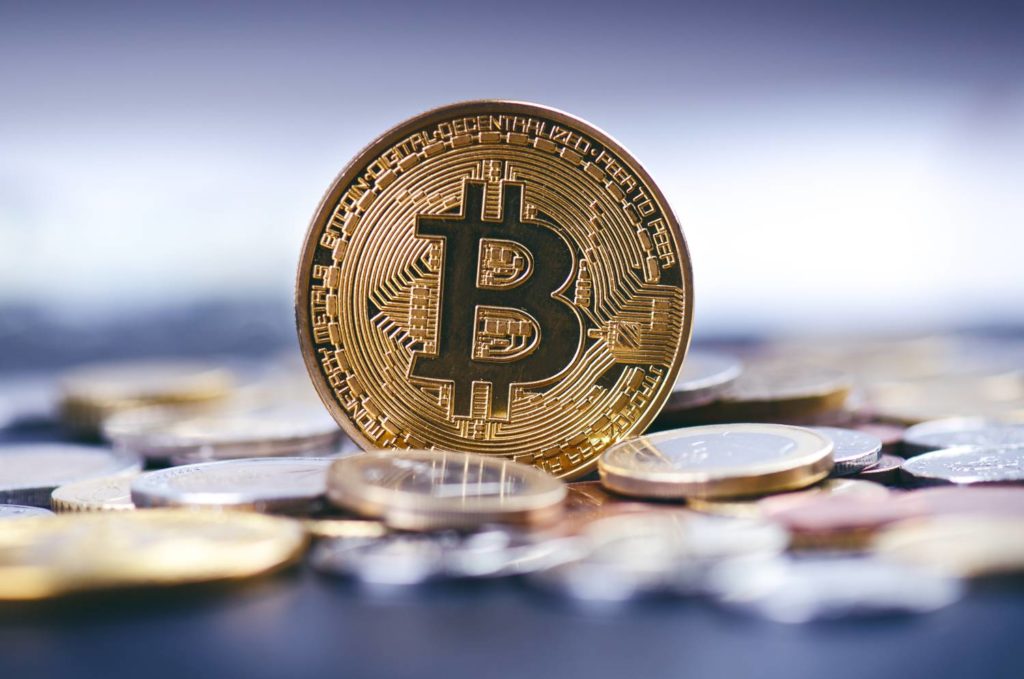- +352 444 222
- Monday-Friday 12:00-18:00
- 20, avenue Marie-Thérèse, 2132 Luxembourg


Created by Satoshi Nakamoto on January 3, 2009, Bitcoin is now the talk of the town. In the now large “family” of crypto-assets, this is the oldest and most valued. Behind a process with a sometimes quite technical lexicon, crypto-assets are the talk of the town, and for the past few weeks, everything has been accelerating. 2021 promises to be a pivotal year in this respect.
After venturing beyond the $40,000 mark during the month of January, the value of bitcoin seems to have no limits, now rising to almost $50,000 USD following recent announcements by Elon Musk and Tesla. As a reminder, this was only $8,000 a year ago.
This meteoric rise has set the news ablaze, and articles on the subject are pouring in. Debates and opinions are manifold, describing crypto-assets as chimerical or futuristic, so much so that some are beginning to parody the<fn phenomenon.>https://www.youtube.com/watch?v=JaMJi1_1tkA&ab_channel=RhymeCombinator{[(|fnote_end|)]}. Faced with this technological craze and the prospects it portends, financial institutions are trying to provide a framework and warn of the excesses of crypto-assets.
We’ll start by clarifying the concept of crypto-assets, then attempt to analyze some of the factors behind the rise of Bitcoin, before identifying its risks and the evolution of regulatory frameworks.
Article L54-10-1 2° of the French Monetary and Financial Code1)https://www.legifrance.gouv.fr/loda/article_lc/LEGIARTI000038509570/2020-10-08 addresses a general definition of crypto-assets by providing:”Any digital representation of value that is not issued or guaranteed by a central bank or public authority, that is not necessarily attached to a legal tender and that does not have the legal status of a currency, but that is accepted by natural or legal persons as a means of exchange and that can be transferred, stored or exchanged electronically.“.
In short, and although some may be able to determine a few characters, crypto-assets in no way have the value or status of money. Not being “issued or guaranteed by a central bank”, these assets have a different mode of operation, and circulate on a “blockchain“.
Crypto-assets, and more specifically Bitcoin, work as follows: Units are exchanged in “transactions“, themselves validated by “miners”, via a cryptographic process placing a time stamp on them so they can be placed in a “block“. This is then integrated into the “blockchain”, acting in the same way as a publicly accessible book. If we were to miss a page, everyone would realize it, and the rest of the story would no longer make sense.
This system guarantees the anonymity of transactions through cryptographic processes, as well as the security of operations2)https://bitcoin.org/fr/comment-ca-marche.
Bitcoins can be obtained in two ways: firstly, by simply purchasing them via a dedicated platform from “fiat” currency3)n.d.l.r: Euros, USD….., secondly, by “mining” as described above. Indeed, a reward system for miners has been put in place, enabling them to obtain a share of the new bitcoins put into circulation, as well as the transaction fees.
Finally, to go into more detail, it is necessary to specify its finite nature. Indeed, in Satoshi Nakamoto’s white paper, the total quantity of bitcoins to be created is set at 21 million. By now, we would have passed the 18 million mark. This should be taken into account, given that all the bitcoins to be created will be created in 2140.
Bitcoin today appears to be a particularly unstable asset, and the recent breakthrough in its value at the dawn of 2021 leads to various attempts at explanation. It is therefore worth analysing a few explanations for this upward trend:
What we can deduce from the rise of crypto-assets, and Bitcoin in particular, seems to be a trend towards anchoring, developing a new technology. Although these factors need to be put into perspective, and the year 2021 will certainly not be the year when Bitcoin becomes the world’s single currency, it will undoubtedly represent a first step towards making the existence of crypto-assets known to as many people as possible.All in all, crypto-assets seem to be on the cusp of a great ascension, and are still likely to be the talk of the town.
However, with this growth, the regulatory challenges are even greater, particularly in terms of the fight against money laundering and the financing of terrorism (AML/CFT). As the use of crypto-assets is by nature designed to make transactions anonymous, the destination of the funds derived from them becomes particularly difficult to identify. Different types of crime continue to emerge, and regulations need to adapt to these changes. At the end of 2020, and following the expansion of crypto-assets, news on the subject has been particularly full.
Among the events that have marked the news in this area, let’s recall the operation of September 29, 2020, which led to 29 people being taken into custody by the national anti-terrorist prosecutor’s office, following the detection by TRACFIN of a circuit for transferring funds to jihadists in combat zones. KEPLERK-type coupons purchased anonymously in tobacco shops in France had been transmitted by secure messaging to jihadists directly present in Syria, then credited on bitcoin exchange platforms7)https://www.lemonde.fr/police-justice/article/2020/09/29/coup-de-filet-dans-une-affaire-de-cyberfinancement-du-terrorisme-29-personnes-en-garde-a-vue_6054090_1653578.html.
We can also mention the sealing of 8 bitcoin distributors (out of 11 in France), enabling the purchase and resale of bitcoins in fiat currency, as part of a vast money-laundering operation. More than €191,000 was seized.
Last but not least, we could also go as far back as the Capitol, whose storming is said to have been partly financed by bitcoin payments worth over 500,000 USD, or 28.15 bitcoins, from a French donor to American far-right militants. This operation would have taken place on December 8, 2020, one month before the events we know8)https://blog.chainalysis.com/reports/capitol-riot-bitcoin-donation-alt-right-domestic-extremism. The information from Chainalysis, a firm specializing in anti-money laundering and digital currency analysis, was picked up by newspapers around the world.
Other typologies could also be mentioned, if only in terms of cybercrime, with ransomware often demanding financial compensation in crypto-assets from victims. In fact, their occurrence “literally exploded” in 2020, according to Guillaume POUPARD, Director General of ANSSI. Indeed, the number of ransomware incidents rose from 54 in 2019 to 192 in 20209)https://www.bfmtv.com/economie/replay-emissions/le-grand-journal-de-l-eco/guillaume-poupard-anssi-le-nombre-de-cyberattaques-explose-en-2020-11-01_VN-202101110328.html. In September 2020, the department published a guide to raise awareness among businesses and local authorities10)https://www.ssi.gouv.fr/actualite/rancongiciels-face-a-lampleur-de-la-menace-lanssi-et-le-ministere-de-la-justice-publient-un-guide-pour-sensibiliser-les-entreprises-et-les-collectivites/.
These cases, marking the transition between 2020 and 2021, are unfortunately not isolated, and crypto-assets are emerging as a tool of choice, a veritable doorway to the commission of illicit activities.
Behind the crypto-asset-related cases we’ve been able to mention, TRACFIN is on its toes. Through its activity report for 2019/2020 published on December 10, 202011)BC/FT risk trends and analysis in 2019-2020, TRACFIN, the service reports an entire section dedicated to cyber and inherent crypto-asset risks. Numerous types of use are mentioned: “support for the commission of fictitious investment scams, support for laundering the proceeds of scams carried out using fictitious identities, means of concealing income or intermediaries in the trade of illicit products“.
In its analysis, the Financial Intelligence Unit deplores the de facto weakening of the AML/CFT system caused by the lack of harmonization of AML/CFT legislation in various European countries. Less stringent legislation, coupled with the European passport and freedom to provide services regimes, would enable PSP/ME establishments to operate in France while being licensed in another EEA country.
A second regret expressed by the department in its report is that of a loophole in the use of prepaid coupons purchased in tobacconists’ shops. The provisions of article R.561-16-1 CMF exempt under certain conditions from the due diligence obligations set out in articles L.561-5 and L.561-6 CMF, thus representing a potential anonymous vector for money laundering and terrorist financing.12)n.d.l.r : The report reconciles this observation with the above-mentioned survey of September 29, 2020..
TRACFIN believes: “first-euro identification should be compulsory for all cash-based physical payment media, except in the case of precisely defined exceptionsIn addition, the company is also looking into the possibility of converting electronic money into crypto-assets, as well as into so-called “cash-for-cash” exchanges.crypto to crypto“.
In addition, the service adds the possibility of setting up a French registration system for any Digital Asset Service Provider (DASP) operating in France under the freedom to provide services, as well as a European alignment of the regulatory framework, to facilitate the detection and transmission of information in this field.
Finally, the emergence of stable-coins (DAI, HAVVEN, TETHER…) also worries the department. These new-generation crypto-assets present stability targets due to their backing by an underlying asset, but the BC/FT risks associated with them remain similar to first-generation crypto-assets (such as Bitcoin). These risks include the anonymity of transactions and the possibility of using them to launder money or finance illicit activities directly on the deep or dark web. In accordance with the observations of the Financial Stability Board13)https://www.fsb.org/2020/10/regulation-supervision-and-oversight-of-global-stablecoin-arrangements/, TRACFIN talks of the need to create an international regulatory framework for stablecoin issuers.
TRACFIN’s report points to a real institutional awareness of technological developments, and highlights the flaws and weaknesses in the current regulatory framework that need to be corrected to prevent the risk of BC/FT. The year 2021 will undoubtedly bring answers as to whether the trends detected by the financial intelligence unit will be realized or confirmed.
There seems to be some reaction to the regulatory framework for crypto-assets. Institutions are trying to keep up with technological developments, and 2021 could be the cradle of a legislative framework more suited to the crypto-asset boom we’re experiencing.
Directive 2018/1673, aimed at combating money laundering through criminal law, is part of this movement. Due for transposition on December 3, 2020, it is the first to include cybercrime as an offence covered by AML/CFT measures, and must be effective in member states by June 3, 2021. This will undoubtedly make it possible to cover a wider range of typologies, while reinforcing the standardization of systems in this field14)https://eur-lex.europa.eu/legal-content/FR/TXT/HTML/?uri=CELEX:32018L1673.
Ordinance 2020-1544 of December 9, 202015)https://www.legifrance.gouv.fr/jorf/id/JORFTEXT000042636234, which reinforces the framework for combating money laundering and the financing of terrorism. Its aim is to provide a stricter framework for Digital Asset Service Providers (DASPs).
This order extends the obligation to register new types of services with the AMF. As such, crypto to crypto exchange services and digital asset trading platforms will now have to carry out this formality. It should be noted, however, that this registration system does not entail any a priori control of the AML/CFT systems put in place by these PSANs, although they may be subject to a posteriori control by the ACPR.
Finally, the letter of report to the President of the Republic16)https://www.legifrance.gouv.fr/jorf/id/JORFTEXT000042636228 suggests that PSANs will soon be tightening their obligations to identify occasional customers before issuing a decree on the freezing of assets. This regulatory change would therefore make it possible to respond to the wishes presented by TRACFIN on this subject in reaction to the September 29, 2020 survey. It also seems to confirm the attempt to take into account as closely as possible the reality of the stakes represented by crypto-assets.
The dynamic of regulation with regard to crypto-assets and cybercrime leads us to assume that institutions have taken full measure of the risks posed by the rise of the new technologies we face. The commitment of the political field in this area, including Mr Bruno Le Maire17)https://twitter.com/BrunoLeMaire/status/1336703944421232640?s=20, or Mrs Christine Lagarde18)https://www.reuters.com/video/watch/ecbs-lagarde-says-bitcoin-conducted-funn-id724167311, reinforces this effect, encouraged by a tense political context in light of recent events.
Let’s not forget that this regulatory craze comes amidst a triple-headed dynamic of booming crypto-assets, developing criminal activity, but also France’s evaluation by the FATF.
In conclusion, if the future of crypto-assets, and Bitcoin in particular, seems set for an ever-increasing rise in importance, their regulation appears to be one of the authorities’ top priorities, with analysis of the inherent risks also continuing. 2021 could be a milestone in terms of future innovations and regulations. Finally, it should be noted that despite the efforts and actions we have put in place, many challenges and harmonization issues remain to be addressed, and others are likely to emerge in the course of the year, notably on the question of stable-coins and the ever closer harmonization of AML/CFT systems.
[+]
| ↑1 | https://www.legifrance.gouv.fr/loda/article_lc/LEGIARTI000038509570/2020-10-08 |
|---|---|
| ↑2 | https://bitcoin.org/fr/comment-ca-marche |
| ↑3 | n.d.l.r: Euros, USD….. |
| ↑4 | https://insights.glassnode.com/bitcoin-liquid-supply/ |
| ↑5 | n.d.l.r: storage method, portfolio |
| ↑6 | https://www.newsanyway.com/2021/01/15/all-you-need-to-know-about-bitcoin-halving/ |
| ↑7 | https://www.lemonde.fr/police-justice/article/2020/09/29/coup-de-filet-dans-une-affaire-de-cyberfinancement-du-terrorisme-29-personnes-en-garde-a-vue_6054090_1653578.html |
| ↑8 | https://blog.chainalysis.com/reports/capitol-riot-bitcoin-donation-alt-right-domestic-extremism |
| ↑9 | https://www.bfmtv.com/economie/replay-emissions/le-grand-journal-de-l-eco/guillaume-poupard-anssi-le-nombre-de-cyberattaques-explose-en-2020-11-01_VN-202101110328.html |
| ↑10 | https://www.ssi.gouv.fr/actualite/rancongiciels-face-a-lampleur-de-la-menace-lanssi-et-le-ministere-de-la-justice-publient-un-guide-pour-sensibiliser-les-entreprises-et-les-collectivites/ |
| ↑11 | BC/FT risk trends and analysis in 2019-2020, TRACFIN |
| ↑12 | n.d.l.r : The report reconciles this observation with the above-mentioned survey of September 29, 2020. |
| ↑13 | https://www.fsb.org/2020/10/regulation-supervision-and-oversight-of-global-stablecoin-arrangements/ |
| ↑14 | https://eur-lex.europa.eu/legal-content/FR/TXT/HTML/?uri=CELEX:32018L1673 |
| ↑15 | https://www.legifrance.gouv.fr/jorf/id/JORFTEXT000042636234 |
| ↑16 | https://www.legifrance.gouv.fr/jorf/id/JORFTEXT000042636228 |
| ↑17 | https://twitter.com/BrunoLeMaire/status/1336703944421232640?s=20 |
| ↑18 | https://www.reuters.com/video/watch/ecbs-lagarde-says-bitcoin-conducted-funn-id724167311 |
Dear users, on 15/06/2022 Internet Explorer will be retiring. To avoid any malfunctioning, we invite you to install another browser, such as Google Chrome, by clicking here, or the one of your choice.
Please check this before contacting us in the event of a problem.
